The John E. Marqusee Collection [251 - 300]
This page contains the sixth fifty medals listed in the John E. Marqusee Collection catalogue. The catalogue, authored by Susan Luftschein, is a wonderful resource for the American Art Medal collector and includes much beyond the simple list of medals. These pages simply attempt to provide a web-searchable repository for medals that are not all shown in the printed edition.










This medal was chosen as the third issue of the prestigious Society of Medalists series in 1931. The obverse bears five Hopi rain dancers, two with snakes in their mouths, two distracting the snakes with eagle feathers, and one crouching to gather up snakes. In exergue, incuse HOPI; at lower right, H A macNeil
The reverse bears dancers racing from mesa onto the desert, hands full of snakes to be returned to their dens. Lightning flashes above. In exergue, incuse PRAYER FOR RAIN; at lower left, incuse ©
This medal's theme was based on bas-relief panels that MacNeil had made decades earlier after a visit to a Hopi reservation. In the brochure accompanying the medal he wrote:
"The two incidents of the Hopi Prayer for Rain on the mesas of northeastern Arizona depicted on this medal are chosen by your sculptor because of the extraordinary vital enthusiasm and power that the Indians throw into this ceremony. Having witnessed it and been thrilled by the intensity of their emotion and on further study by the complicated and perfectly natural development of this drama, I cannot help feel that in it we find a basic note underlying all religions. All these Southwest Indians, living as they do in an arid region, have developed their religion along the lines of their greatest need - water."
This is one of the SOM medals that come in several strikingly different finshes. You can scroll the medal images between variants.
Struck by the Medallic Art Company of New York, the medal is an ovoid measuring 74mm x 70mm. The reported mintage of this medal is 1,713 medals in bronze and 25 in silver.
References: Baxter 354, Marqusee 251

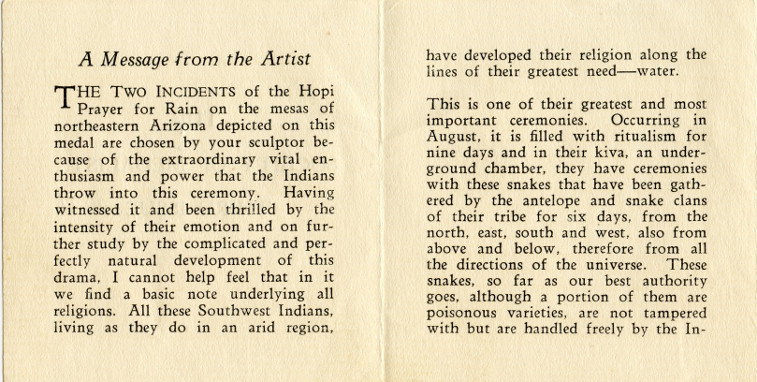
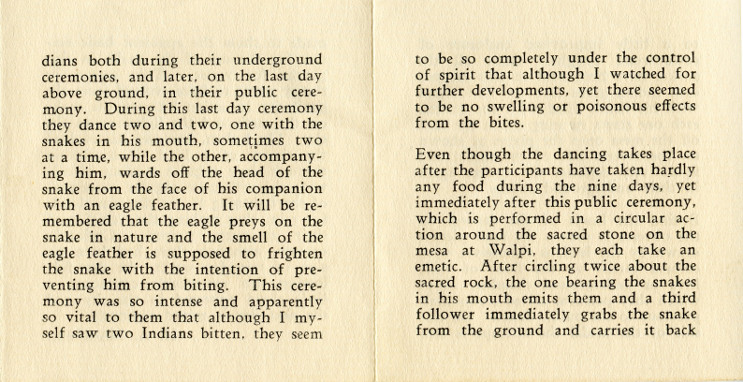



The medal's obverse bears a figure representing New York, seated on a throne, holding burning torch in one hand, skyscraper in other. Around, TERCENTENARY / NEW YORK / 1914.
The reverse depicts the ship New Netherland which brought the first settlers to New Amsterdam in 1623, flanked by Dutchman with musket and Native American with bow and peace pipe; beaver below. Around, NEW NETHERLAND FOUNDED / 1614.
This medal is the eleventh issue in the prestigious and highly collectible Circle of Friends of the Medallion series.
References: Marqusee 253




The obverse bears profile of Roosevelt, facing left. Around, in two lines, · FRANKLIN · DELANO · ROOSEVELT · - · 31ST · PRESIDENT · OF · THE · UNITED · STATES / · 1933 · · 1937 · - · JOHN · NANCE · GARNER · VICE · PRESIDENT; signed under truncation, PMANSHIP ©
The reverse bears U.S.S. Constitution heading left above winged female in flight, surrounded by beaded border. Around, : THOU · TOO · SAIL · ON · O · SHIP · OF · STATE : SAIL · ON · O · UNION · STRONG · AND · GREAT
Roosevelt's profile is modeled in such high relief that it took 12 strikes from the great presses at the Mint to render the finer details. Roosevelt himself apparently suggested the "Old Ironsides" motif for the reverse. Manship placed the winfed female figure underneath to represent the modern day "Ship of State."
I do not have many U.S. Mint medals in my collection, but this one is really quite handsome. According to Joe Levine, many collectors believe this to be the handsomest of all bronze inauguration medals.
The medal measures 76.2mm (2 5/8in) in diameter and was struck in bronze by the U.S. Mint. The mintage was 1500. The second variant represents medals struck by the Medallic Art Company. Apparently, the dies for this medal were fabricated at the Medallic Art Company in New York and approximately 50 medals were struck there before the dies were sent to the U.S. Mint.
Many thanks to a collector who wishes to remain anonymous for telling me about and sending me picturesof the Medallic Art variant.
References: Marqusee 254; Murtha 332






This medal was chosen as the 2nd issue of the prestigious Society of Medalists series. The obverse bears a grape-crowned, bearded god of wine over shallow, two-handled kylix. Around, in two lines, HAIL - TO - DIONYSUS - WHO - FIRST - DISCOVERED / THE - MAGIC - OF - THE - GRAPE. The reverse bears youthful satyrs trampling grapes. Below, signed © / .P.MANSHIP 1930.
Manship's medal proved to be highly controversial and thus provided much needed publicity for the still young Society of Medalists. America was still nominally observing Prohibition and at least one member is reported to have resigned over this "glorification of wine."
The medal measures 73mm in diameter. The Medallic Art Company of New York struck a reported 1,950 medals in bronze and 50 in silver.
References: Marqusee 256
All that being said, this medal in bronze typically trades on eBay between $180 and $230. Silver variants come up very rarely and can fetch several hundred dollars, typically in the $400 to $1,000 range.



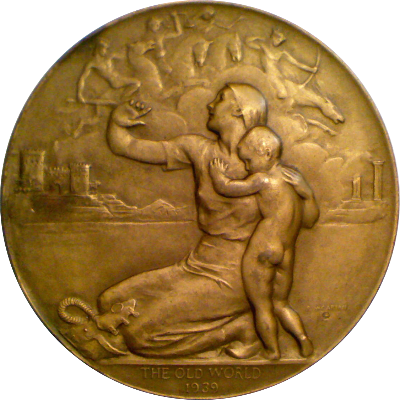
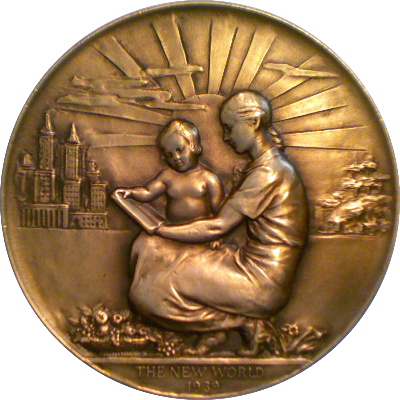
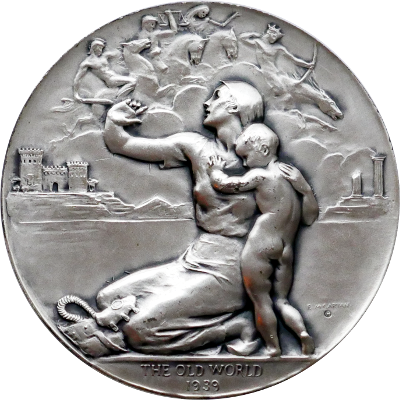
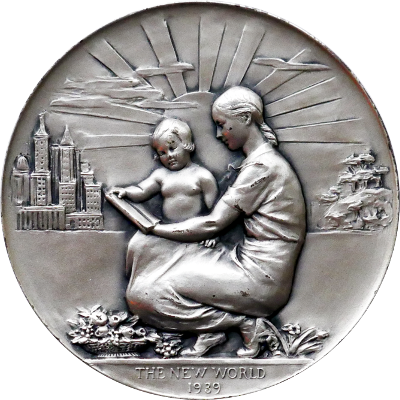
This medal was chosen as the 19th issue of the prestigious Society of Medalists series in 1939.
The obverse bears kneeling mother with child cowering before Four Horsemen of the Apocalypse in sky above; serpent-like gas mask at her knee, castle and ancient ruin in background. In exergue, THE OLD WORLD / 1939; in lower field, E. McCARTAN / ©
The reverse bears mother in 1930s dress with book and child, basket of flowers by her knee, skyscrapers left, forst right, under radiant sun. In exergue, THE NEW WORLD / 1939
At the time this medal was being designed the situation on the European continent had deteriorated so much that all-out war seemed likely. America seemed far-removed from the insecurities and problems that the old world was facing. Americans looked over the Atlantic and were very much disinclined to get involved in yet another Great War. As McCartan wrote in his "From the Artist":
"The broad Atlantic Ocean thankfully isolates is from forces which destroy life and liberty and which impede the normal pursuit of happiness."
Of course, it did not turn out quite the way McCartan and many fellow Americans had hoped. America officially entered World War II in 1941 after already having provided substantial material assistance to its European Allies.
This medal measures 73mm in diameter and was struck by the Medallic Art Company of New York. The reported production quantity of this medal is 943 pieces in bronze and 100 in silver.
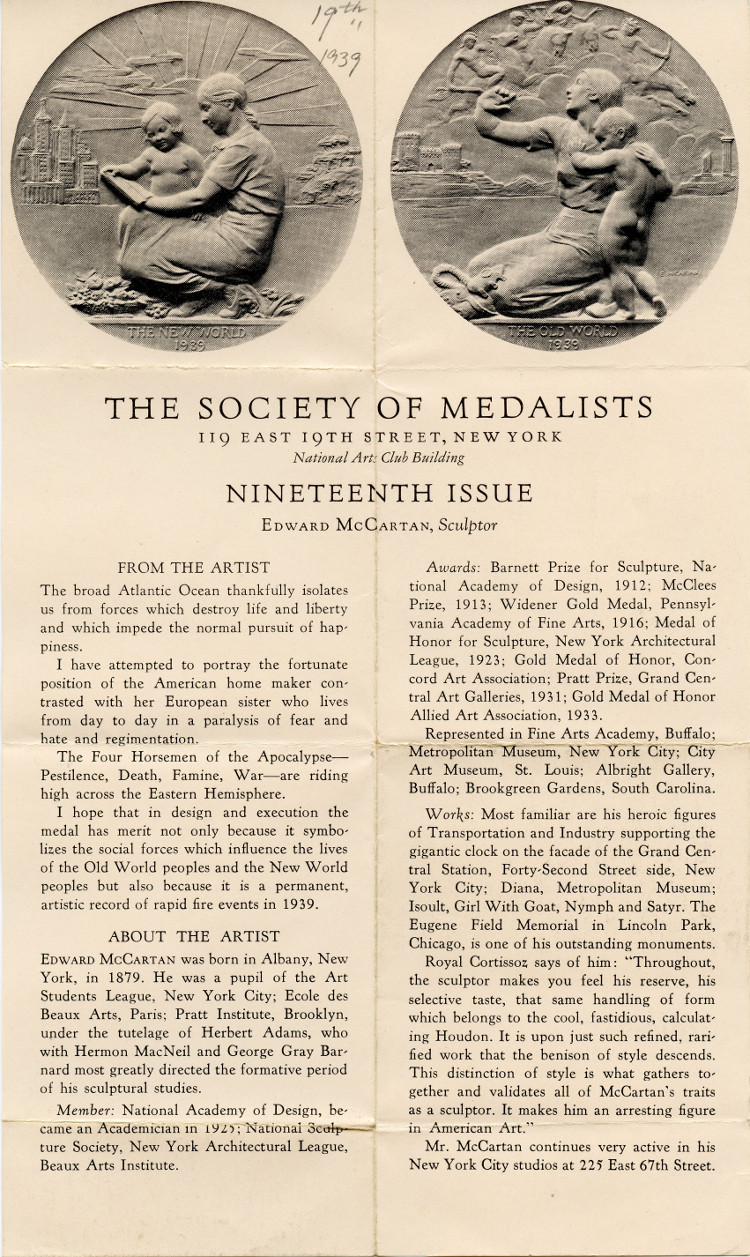
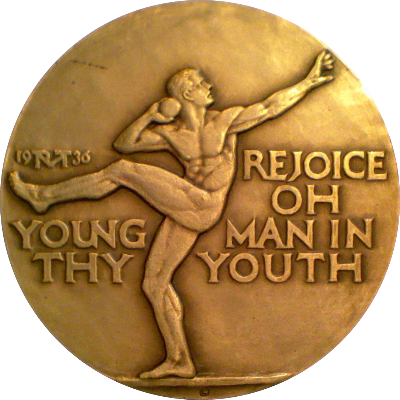
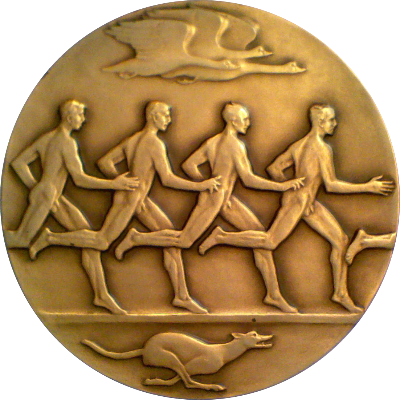
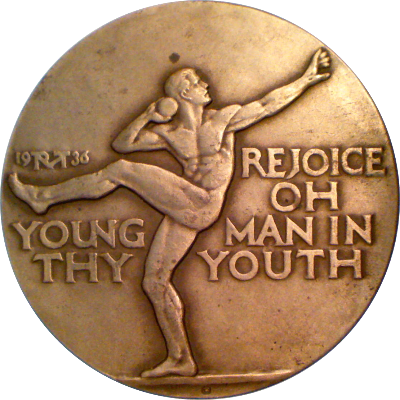
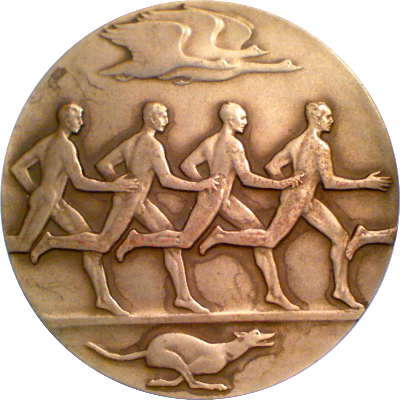
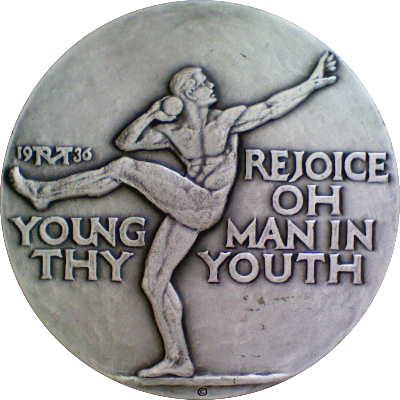

This medal was chosen as the 13th issue of the prestigious Society of Medalists series in 1936. The obverse bears a line of five runners, flying geese overhead, slim whippet racing below. The reverse bears a nude athlete putting the shot. Flanking the athlete, 19 (RTM monogram) 36 - REJOICE / OH / YOUNG - MAN IN / THY - YOUTH; in exergue, ©
Robert Tait McKenzie is rightly famous for his athletic subjects and this medal is a good example. As he wrote in the brochure accompanying the medal:
"The last fifty years has shown a revival and spread of interest in competitive athletic sports
and outdoor life that has no parallel in the history of the world...
As one who has followed this great movement from its inceptionto maturity I have chosen two phases of
it for the thirteenth medal issued by the Society."
This medal measures 73mm in diameter and was struck by the Medallic Art Company of New York. The reported production quantity of this medal is 1,001 in bronze and 100 in silver.
References: Kozar 109, Marqusee 269
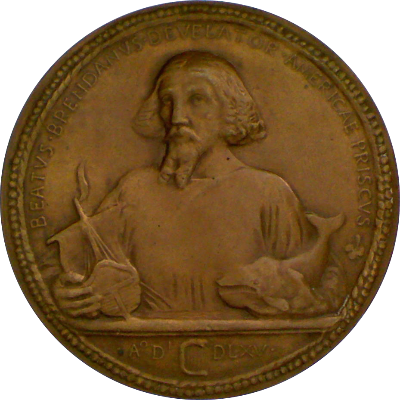

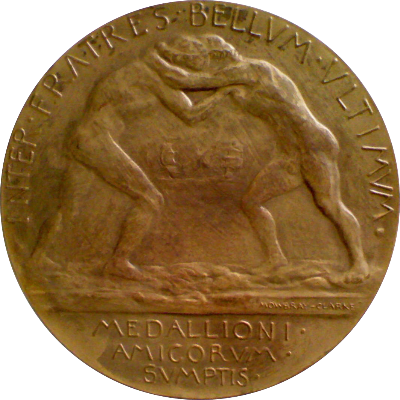

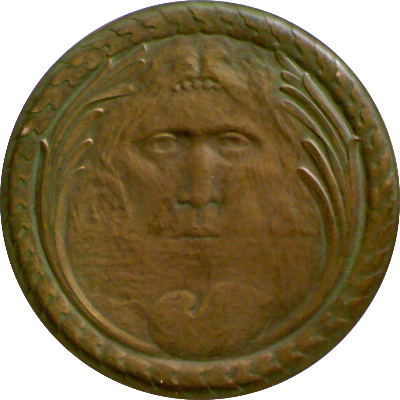
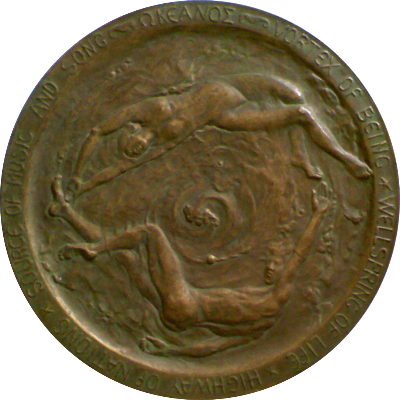


This medal was chosen as the 32nd issue of the prestigious Society of Medalists series.
The medal's obverse bears an American soldier giving water to a wounded comrade. In exergue, (circled BN) / ©. The reverse bears a mushroom cloud of a nuclear explosion over avast plane of corpses. To left and right, WORLD UNITY - OR OBLIVION.
In his "Message from the Artist" Nebel wrote:
"Modern warfare has developed to such a degree that civilization may vanish from the earth unless there is to be an understanding among nations, and this medal was designed to help impress that thought which, I believe, is uppermost in our minds."
It is fascinating to see this medal in the context of its predecessor (For Conquer We Must). The prior medal is soul-stirring and up-lifting in its depiction of courageous soldiers at one of the iconic moments of war. Only half a year later, the war has been won, and soldiers are depicted wounded or dead. The price of victory and the question of "What now?" has arrived very prominently.
The medal measures 73mm in diameter. The Medallic Art Company of New York reportedly struck 839 medals in bronze and 60 (out of 700 authorized) in silver.


This medal was published in June 1915 as the 12th issue in the Circle of Friends series.
Its obverse bears bust of Joan of Arc r. with cuirass and sword. Around, CHRISTI MILES - BEATA JOANNA D'ARC (soldier of Christ, blessed Joan of Arc); at lower right, NEWMAN
The reverse shows seated semi-nude France holding burning heart and supporting the Arms granted Joan's family by King Charles VII. Incuse legend around, POVR L'HONNEVR DE LA FRANCE (for the honor of France) / MCCCCCXXXI; at lower left, NEWMAN
The medal measures 70mm in diameter and was produced by the Medallic Art Company of New York.

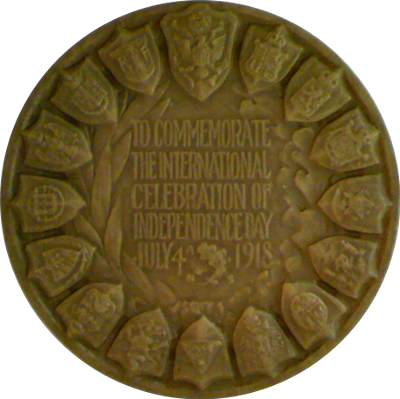
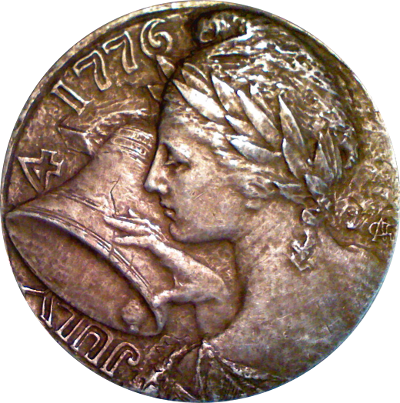
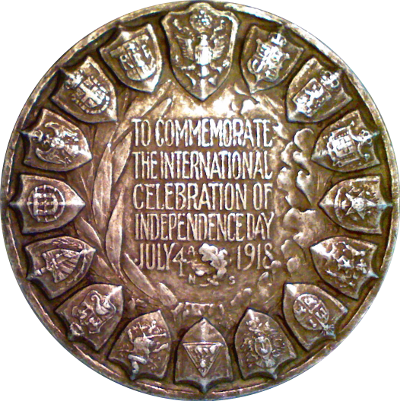
The obverse bears allegorical female lightly touching the Liberty Bell. Around, JULY 4 1776; at right, signed (AGN monogram).
The reverse depicts a circle of shields bearing the arms of the sixteen countries participating in the celebration. In center, TO COMMEMORATE / THE INTERNATIONAL / CELEBRATION OF / INDEPENDENCE DAY / JULY 4 (ANS oak leaves) 1918.
This is the 36th medal issued by the American Numismatic Society. Though dated 1918, the medal was actually issued in 1919 to commemorate the international celebration of the American Independence Day in the previous year. The sixteen nations that had participated in the festivities (other than the United States) were: the United Kingdom, Belgium, Greece, Brazil, Chile, Uruguay, Argentina, Nicaragua, Guatemala, Peru, Cuba, Portugal, Serbia, Italy, and France.
The medal measures 63mm (2.5in) in diameter and was struck in bronze and silver. Only 39 silver and 63 bronze pieces were struck by the Medallic Art Company of New York and made available to ANS members and members of the Mayor's Committee on National Defense.